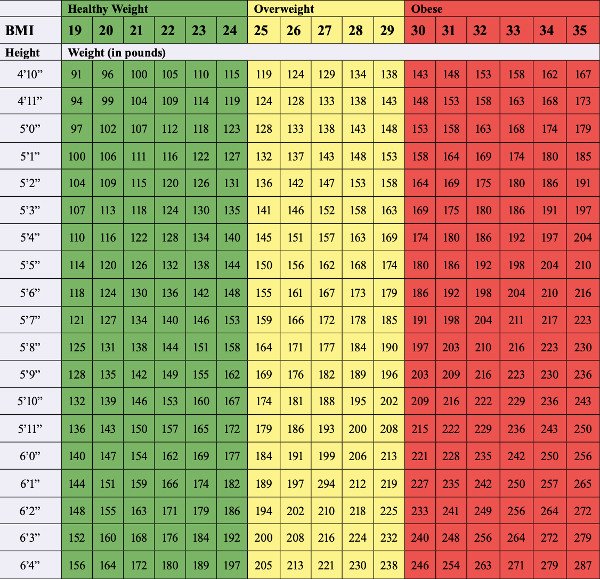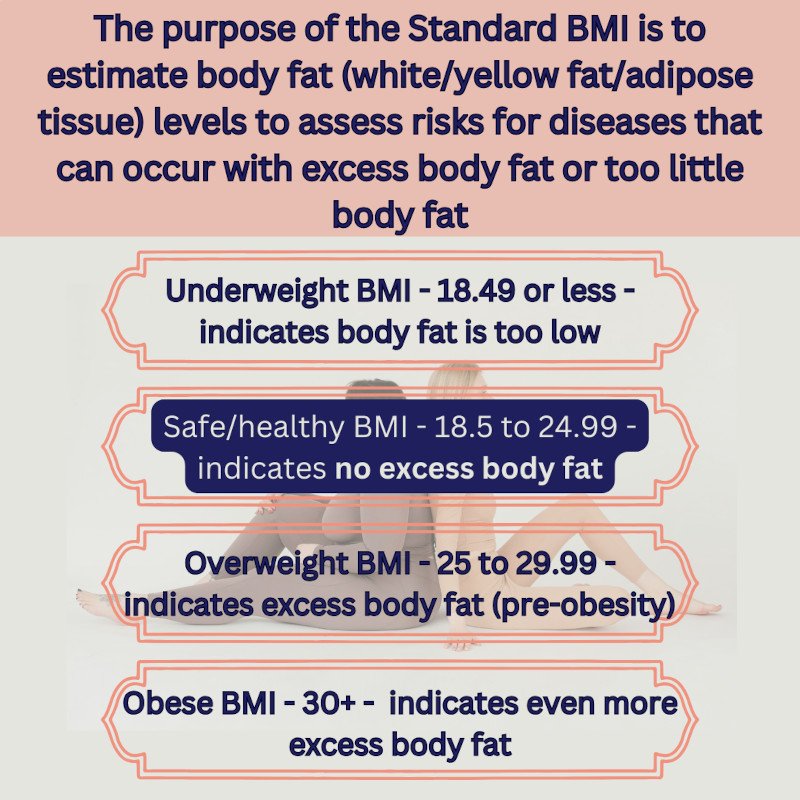Skinny Fat is a Lack of Genetic Muscle – Beyond Normal-Weight Obesity

The last time the Standard BMI was officially updated through proper, official channels was in 1998 (1, 2, 3). At that time, the NIH changed the threshold for “overweight”, officially lowering it to a BMI of 25 and aligning it with World Health Organization guidelines. The only thing the Standard BMI does, via height and weight, is estimate body fat to assess health risks.
 That is literally the only thing the BMI does, estimate body fat to assess health risks (4, 5, 1, 3). It does nothing else (no, it does not estimate health, only healthy weight). Yes, the accuracy of the BMI is debatable, for sure. However, the simple definition of the Standard BMI is not debatable — it is set in stone until changed via official protocol.
That is literally the only thing the BMI does, estimate body fat to assess health risks (4, 5, 1, 3). It does nothing else (no, it does not estimate health, only healthy weight). Yes, the accuracy of the BMI is debatable, for sure. However, the simple definition of the Standard BMI is not debatable — it is set in stone until changed via official protocol.
This is the current official Standard BMI scale:
18.49 or less – underweight, not a healthy weight due to too little regular white/yellow body fat (common adipose tissue)
18.5 to 24.99 – normal weight, healthy weight due to no excess regular white/yellow body fat (common adipose tissue)
25 to 29.99 – overweight, not a healthy weight due to too much/excess regular white/yellow body fat (common adipose tissue)
30+ – obese, not a healthy weight due to way too much/excess regular white/yellow body fat (common adipose tissue)
Beyond Normal Weight Obesity – Skinny Fat is a Lack of Genetic Muscle
In 2016, the NIH released its first-ever (initial) definition for normal-weight obesity (skinny fat)(6):
“Normal-weight obesity syndrome is characterized by excess body fat in individuals with adequate body mass index (18.5-24.9 kg/m(2))”

Which directly contradicts the Standard BMI definition (1, 2, 3, 4, 5). No official change to the BMI happened – the BMI definition/scale did not change.
Yet, the vast majority of people everywhere, like 80%+, including licensed medical doctors, magically, arbitrarily have changed the official Standard BMI definition to mean that it includes people within safe BMI (18.5 to 24.99) who have too much/excess regular white/yellow fat. Which is false. You cannot be within safe BMI and have too much regular white/yellow fat – this directly violates the Standard BMI definition and renders it useless.
No one can randomly, arbitrarily change an established standard on a whim, including licensed medical doctors. No matter what. The Standard BMI has not been officially changed since that 2016 study. No study gives anyone – including medical doctors – the magical power to redefine any standard definition as they want/on a whim. Yet, that is what like 80%+ of people everywhere, especially online (Google, Bing, DuckDuckGo, etc.), particularly on social media, are doing, including licensed medical doctors. Most people do not understand what the Standard BMI is or does, let alone what skinny fat (lack of genetic muscle) is.
Skinny Fat is a Lack of Genetic Muscle
 Skinny fat science is very young, and data, evidence, and facts are very limited. That initial NIH definition was merely that, initial; we had to start somewhere. Our skinny fat science (7, 8) is leading the way and revealing that skinny fat is a lack of genetic muscle (9, 10, 11, 12, 13). You can technically lose 100% of your regular white/yellow body fat (body fat %, common adipose tissue), yet your skinny fat (lack of genetic muscle tissue) will remain. Regular fat and skinny fat are two different things — they are not the same (13).
Skinny fat science is very young, and data, evidence, and facts are very limited. That initial NIH definition was merely that, initial; we had to start somewhere. Our skinny fat science (7, 8) is leading the way and revealing that skinny fat is a lack of genetic muscle (9, 10, 11, 12, 13). You can technically lose 100% of your regular white/yellow body fat (body fat %, common adipose tissue), yet your skinny fat (lack of genetic muscle tissue) will remain. Regular fat and skinny fat are two different things — they are not the same (13).
A person experiencing normal weight obesity (skinny fat) is not experiencing too much regular white/yellow fat when within safe BMI — they are experiencing underdeveloped genetic muscle tissue (9, 10, 11, 12, 13). Where that underdeveloped muscle tissue is lacking, skinny fat tissue exists in its place. Our science has identified two types of skinny fat tissue. The first type is thin fat (9), which exists when genetic muscle tissue is lacking in development. The second type is cellulite (9), and it also can exist where genetic muscle tissue should be, but is not.
The more underdeveloped genetic muscle tissue (skinny fat) a person has, the more prone (14, 16, 17, 10) they are to no less than having a slower metabolism, decreased glucose uptake, insulin resistance, too much/excess regular white/yellow fat (being overweight or obese), hormone(s) imbalance, disease, and other health issues. Understanding your unique genetic body composition (15), metabolism (16), and shape (15) along with the best diet (17), exercise (18), and lifestyle (19) for you is the best way to manage skinny fat in the short and long term. Our Scientific Health Quizzes help you better understand all of that.
Skinny Fat Is More Than Just Normal-Weight Obesity
References
- NIH, National Library of Medicine: Body Mass Index. April 7, 2015, Frank Q Nuttall. https://pmc.ncbi.nlm.nih.gov/articles/PMC4890841/
- The New York Times: A Number That May Not Add Up, April 14, 2014, Jane E. Brody. https://archive.nytimes.com/well.blogs.nytimes.com/2014/04/14/a-number-that-may-not-add-up/
- Wikipedia: Body mass index. https://en.wikipedia.org/wiki/Body_mass_index
- NIH: National Heart, Lung, and Blood Institute: Calculate Your BMI. https://www.nhlbi.nih.gov/calculate-your-bmi
- Mayo Clinic: Mayo Clinic BMI and waist circumference calculator, 2013. https://www.mayoclinic.org/diseases-conditions/obesity/in-depth/bmi-calculator/itt-20084938
- NIH, National Library of Medicine: Normal-weight obesity syndrome: diagnosis, prevalence, and clinical implications, September 2016 (Epub Jul 29, 2016), Lana P Franco, Carla C Morais, Cristiane Cominetti. https://pubmed.ncbi.nlm.nih.gov/27473199/
- Fellow One Research: Body Type Science Research Data. https://www.fellowone.com/category/fellow-one-research/the-four-body-types/body-type-science/body-type-quiz/research-data/
- Fellow One Research: Skinny Fat Science. https://skinnyfat.fellowone.com/skinny-fat-science/
- Skinny Fat Science: What Is Skinny Fat?, July 26, 2024. https://skinnyfat.fellowone.com/skinny-fat-science/what-is-skinny-fat/
- Skinny Fat Science: Is Muscle/Mass Genetic and How Does It Affect Skinny Fat?, November 20, 2024. https://skinnyfat.fellowone.com/skinny-fat-science/is-muscle-mass-genetic-and-how-does-it-affect-skinny-fat/
- Skinny Fat Science: Is Skinny Fat Genetic?, November 27, 2024. https://skinnyfat.fellowone.com/skinny-fat-science/is-skinny-fat-genetic/
- Skinny Fat Science: Skinny Fat Is More Than Just Normal-Weight Obesity, April 2, 2025. https://skinnyfat.fellowone.com/skinny-fat-science/skinny-fat-is-more-than-just-normal-weight-obesity/
- Skinny Fat Science: Are Regular Fat and Skinny Fat the Same Thing?, August 28, 2024. https://skinnyfat.fellowone.com/skinny-fat-science/are-regular-fat-and-skinny-fat-the-same-thing/
- Skinny Fat Science: Skinny Fat & Insulin Resistance, June 4, 2025. https://skinnyfat.fellowone.com/skinny-fat-science/skinny-fat-insulin-resistance/
- Skinny Fat Science: Skinny Fat Body Type Science, October 23, 2024. https://skinnyfat.fellowone.com/skinny-fat-science/skinny-fat-body-type-science/
- Skinny Fat Science: How Skinny Fat Affects Metabolism, August 7, 2024. https://skinnyfat.fellowone.com/skinny-fat-science/how-skinny-fat-affects-metabolism/
- Skinny Fat Science: The Best Skinny Fat Diet, According to Science, July 29, 2024. https://skinnyfat.fellowone.com/skinny-fat-science/the-best-skinny-fat-diet-according-to-science/
- Skinny Fat Science: The Best Skinny Fat Exercise, According to Science, August 2, 2024. https://skinnyfat.fellowone.com/skinny-fat-science/the-best-skinny-fat-exercise-according-to-science/
- Skinny Fat Science: The Best Skinny Fat Lifestyle, According to Science, August 14, 2024. https://skinnyfat.fellowone.com/skinny-fat-science/the-best-skinny-fat-lifestyle-according-to-science/












